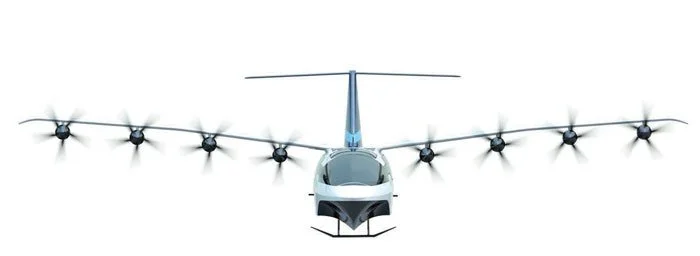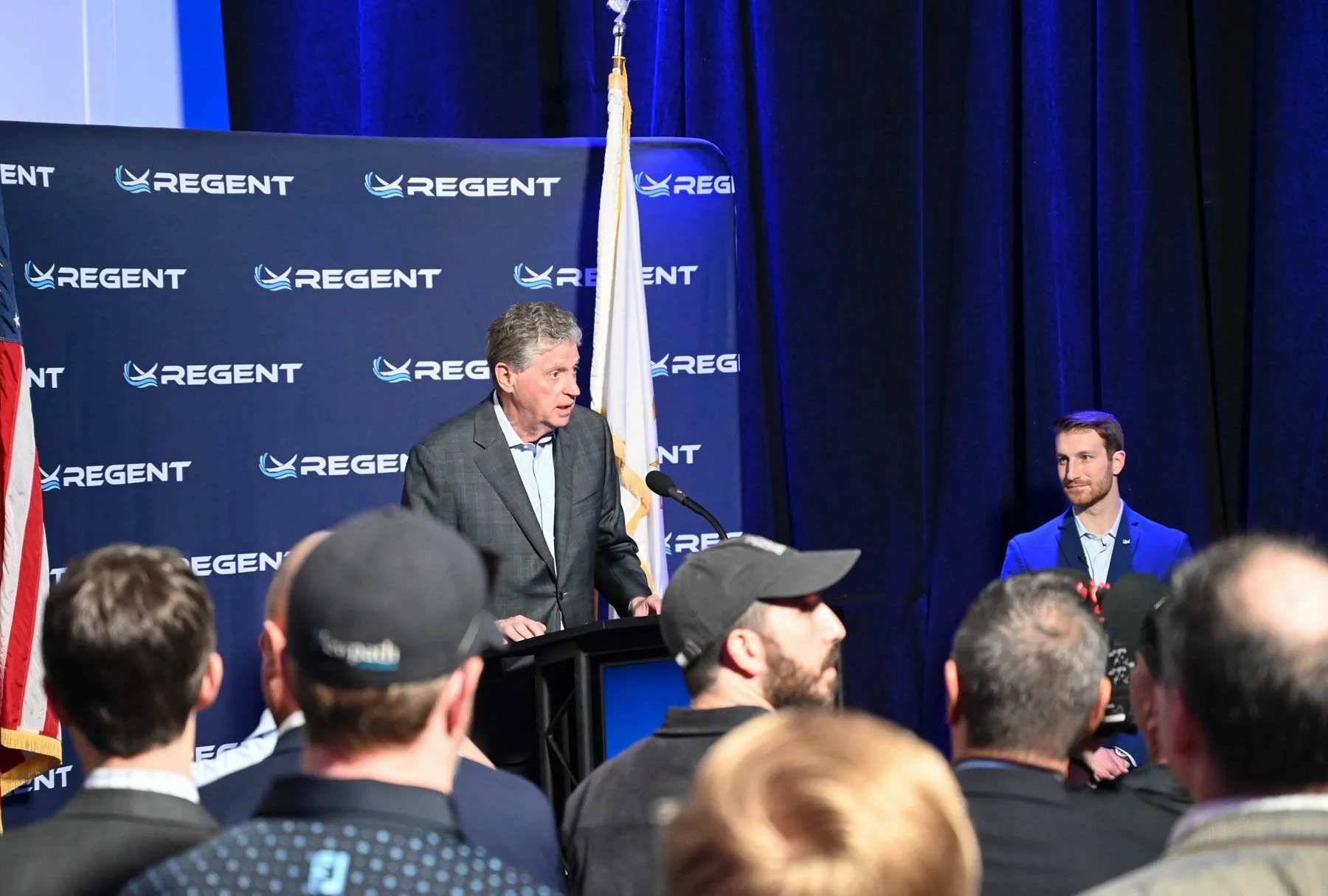Oliver Moore introduces key team members on the project: ‘Bryan Baker and Andrew Gaynor both came straight out of the America’s Cup world. Bryan is the chief engineer of vehicle performance and Andrew is the structures lead.
‘Bryan was with Oracle and then Team Ineos in the last cup. He is one of the few people in the world who has designed both electric aircraft and high-performance racing yachts. He did a stint at Aurora Flight Sciences which is where he connected with a handful of the Regent team, so he is a cross-over link between the America’s Cup and aerospace worlds.
‘Andrew was with Oracle for several cup cycles where he connected with Bryan and then was lead rig designer for American Magic in the last cup. Andrew and I have sailed A-class and C-class cats together for 12 years and we worked together during the last American Magic build.’
Bryan Baker takes up the story: ‘Recent advances in America's Cup hydrofoiling have been critical for Regent. The company is developing a fully electric Wing-in-Ground-Effect (WIG) vehicle, coined the seaglider. Limited only by today's battery technology, Regent aims to develop a vehicle capable of reaching 180mph on the aero-wing. To achieve this performance we have to develop a streamlined hull and reduce our take-off drag. Most float planes achieve take-off by generating speed on a planing hull form which produces significant drag. The planing hull form requires relatively flat water and significant thrust to achieve take-off speed.
‘At Regent we aim to reduce this thrust demand by incorporating three modes of operation: from the hull (float) to the hydrofoils (foil) to the aero-wing (flight). This transition affords us a two-stage drag reduction. The vehicle first reduces wetted area from the hull clearing the water and further reduces all hydro drag as it takes off onto the aero wing. This transition directly impacts our power demands keeping us in a favourable range and weight for current battery technology. Akin to the take-off of an AC75, we concentrate on reducing hull drag via length-to-beam ratio keeping our hull form at a low Froude number. Our front foil positioned closest to our centre of gravity provides the majority of our hydrodynamic lift.
‘We control this lift by actuating symmetric flaperons on the foils which provide lift and, if articulated at different angles, can control roll. In the most recent America's Cup, several concepts were attempted to add flaps to the hydrofoils. The hinge position, stiffness of the foils, fairness of joints or skins and hydraulic actuation all played a pivotal role in drag reduction, avoiding cavitation at higher speeds and aiding controllability. At Regent, these lessons learned are critical in developing a safe and reliable hydrofoil system. On landing, we rely on the hull to provide our deceleration as the foils will be retracted into the hull body. Again, lessons learned from retraction systems developed on the AC50 provide guidance in reducing mass and delivering a reliable retraction system.’
Aero and hydro: two mindsets
Baker and Gaynor bring maritime experience to an impressively experienced and talented team of aerospace engineers. Founders Billy Thalheimer and Mike Klinker are both MIT graduates who worked with chief engineer Dan Cottrell at Aurora Flight Sciences, a research subsidiary of Boeing.
‘The meshing of the aerospace and AC engineers has been really interesting to watch,’ Moore says. ‘In the marine world we are very comfortable iterating designs with real world testing. We stopped putting test pilots up in experimental aircraft to see what would happen a long time ago and for very good reasons. As a result the marine engineers have a deep pool of real-world experience to draw upon but the aircraft engineers have an exceptionally diligent design process of validating their models and simulations to make sure that chances of failure are within very clearly defined acceptable ranges. It was impressive to watch the two mentalities mesh and the result was a very quickly executed vehicle that has been very successful in its mission so far.’ The collaboration has created a system that is agile with strong checks and balances that ensure both safety and repeatability.
It’s a boat, not a plane
Ground effect aeroplanes have been around for a long time but Moore notes that Regent is combining new technology with a fresh approach. ‘Flight control systems have been developing so rapidly in the last few decades. We’ve all seen it in the drones we buy for our kids. You're not actually flying the craft, the computer is, and you are telling it which way to go. The electric propulsion also adds an interesting element. It allows you to use many small propellers instead of a few big ones. This distributes the flow from the thrust evenly over the wing creating a blown wing effect like apparent wind in sailboats giving more lift earlier and allowing for slower take off speeds.’
Given that Regent’s design is a WIG that lands on her hull, she is technically a boat and therefore governed by the US Coast Guard. This leads to fewer regulatory hurdles than the electric planes other companies are developing. ‘The FAA requires you to carry 30 minutes reserve fuel in the daytime and 45 at night, so you can always make it to an airport, which, when we are talking about short distance flights and batteries, is a major weight penalty. Because this is a boat and it can always land on the water, the Coast Guard doesn’t have those requirements.’
There are plenty of wild ideas on the leading edge of any industry, Moore admits, but he believes Regent has a great shot at success. ‘The seaglider is differentiated. It uses existing technology and has demonstrated customer demand – it makes sense.’ Design for the first full-sized seaglider is well under way and the build is scheduled for 2023. Regent is tracking to a 2025 vehicle delivery.
And of course, sailing’s top engineers always enjoy being stretched. As Baker says: ‘This project is a ton of fun. Working with Moore Brothers has been crucial in the rapid development of our 18ft technology demonstrator. In nine months we went from blank sheet to the vehicle hitting 38kts foiling. We are leveraging both aerospace and maritime knowhow to push electric propulsion technologies. I've been fortunate to work with super-talented people in both these worlds in the AC and on eVTOL projects (eVTOL - Electric Vertical Take-off and Landing Plane). The seaglider is a supercool marriage of these technologies.
Making it happen
Regent originally sought out Moore Bros for their composite expertise, but they’ve also come to appreciate the company’s get-it-done attitude. ‘When they started with us,’ Moore says, ‘they had the general concept reasonably sorted but it was a blank sheet of paper on how we were going to build it. We dived in and helped them design around available materials and with processes that matched our capabilities. It was an ambitious undertaking but we developed a very strong working relationship to the point that their lead engineer had his own office in our building. Once we had the parts built we transitioned into helping to support their integration testing operations. It didn’t matter what the problem was. Brake lines on the trailer? We’ve got a local trailer guy. Space on the waterfront for testing? We connected them with Halsey Herreshoff and got them up and running here in Bristol. In our world we are used to the idea that there is a date for the first race and it is going to happen whether you are there or not. Schedule creep isn’t an option and we brought that same mindset to the Regent build. They figured out early on that we were going to do whatever it took, so now they lean on us for a lot. It's been a big challenge but also a really fun partnership.
As Regent is designing the full-scale vehicle, Moore Brothers built a full-sized test wing that has working flaps and is covered with pressure sensors to validate their CFD work. ‘It's a constant R&D project,’ says Jacques Swart, head of sales for Moore Brothers. ‘As soon as Regent comes up with something new, we get it built so they can continue with their testing. The synergy with the team to provide what they need, within their time frame is pretty big.’
Picking up personnel
In order to keep up with the Regent project while also maintaining their regular workflow, Moore Brothers are actively recruiting. ‘We need to hire several more floor techs,’ Moore says. ‘The people we've picked up already have some serious experience. Kenny Madeiro brought a crew to us from Hall Spars and the guys we've had with us forever, like Jeff Kent and Mark Raymond are still here. We've been working very hard to organically build a strong and dedicated crew, and we've put a major focus on a supportive work environment – because in the bespoke composite world, a manufacturer is only as good as the guys on the floor. It doesn’t matter how many machines or fancy tools you have; when you’re building custom composites, you can't robot your way out of a problem, you need to have some creative problem solvers in your team.’
Finding the right personnel has been their biggest challenge, Swart admits. ‘We’re always very selective because synergy is so important. If the right person comes along, we’ll find a spot for them. That’s going to pay off in the long run’.









